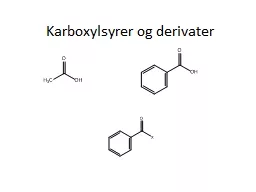PPT-Karboxylsyrer og derivater
Author : natalia-silvester | Published Date : 2017-04-18
Functional groups Acid and esters Formic acid 141 Karboxylsyrer Structure Carboxylic acid groups consist of two very polar functional groups Carbonyl group Hydroxyl
Presentation Embed Code
Download Presentation
Download Presentation The PPT/PDF document "Karboxylsyrer og derivater" is the property of its rightful owner. Permission is granted to download and print the materials on this website for personal, non-commercial use only, and to display it on your personal computer provided you do not modify the materials and that you retain all copyright notices contained in the materials. By downloading content from our website, you accept the terms of this agreement.
Karboxylsyrer og derivater: Transcript
Download Rules Of Document
"Karboxylsyrer og derivater"The content belongs to its owner. You may download and print it for personal use, without modification, and keep all copyright notices. By downloading, you agree to these terms.
Related Documents

